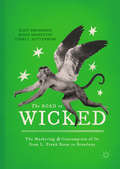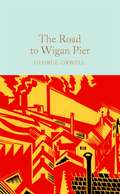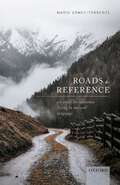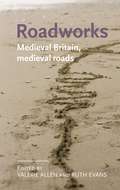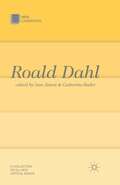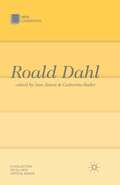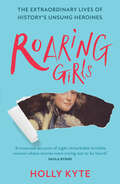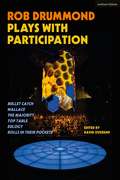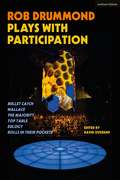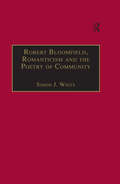- Table View
- List View
The Road To Somewhere: A Creative Writing Companion (PDF)
by Robert Graham Helen Newall Heather Leach Julie Armstrong John SingletonThis revised, updated and expanded new edition of The Road to Somewhere will help you to acquire the craft and disciplines needed to develop as a writer in today's world. It is ideal for anyone - student writers, writing teachers and seasoned authors - seeking practical guidance, new ideas and creative inspiration. The Road to Somewhere: A Creative Writing Companion, second edition offers: - new chapters on writing for digital media, flash fiction, memoir, style and taking your writing out into the world - updated chapters on fiction, scripts, poetry, and experimental forms - an examination of creative processes and advice on how to read as a writer - many practical exercises and useable course materials - extensive references and suggestions for further reading - information on how to get work published or produced, in real and virtual worlds - tips on how to set up and run writing workshops and groups - a complete Agony Aunt section to help with blocks and barriers - guidance on the more technical aspects of writing such as layout and grammar. And, to lighten your writing journey a little, we've tried to make this second edition even wittier and smarter than the first. So whether you see yourself as a published professional or a dedicated dabbler, this is the book to take along for the ride.
The Road To Somewhere: A Creative Writing Companion
by Robert Graham Helen Newall Heather Leach Julie Armstrong John SingletonThis revised, updated and expanded new edition of The Road to Somewhere will help you to acquire the craft and disciplines needed to develop as a writer in today's world. It is ideal for anyone - student writers, writing teachers and seasoned authors - seeking practical guidance, new ideas and creative inspiration. The Road to Somewhere: A Creative Writing Companion, second edition offers: - new chapters on writing for digital media, flash fiction, memoir, style and taking your writing out into the world - updated chapters on fiction, scripts, poetry, and experimental forms - an examination of creative processes and advice on how to read as a writer - many practical exercises and useable course materials - extensive references and suggestions for further reading - information on how to get work published or produced, in real and virtual worlds - tips on how to set up and run writing workshops and groups - a complete Agony Aunt section to help with blocks and barriers - guidance on the more technical aspects of writing such as layout and grammar. And, to lighten your writing journey a little, we've tried to make this second edition even wittier and smarter than the first. So whether you see yourself as a published professional or a dedicated dabbler, this is the book to take along for the ride.
The Road to Wicked: The Marketing and Consumption of Oz from L. Frank Baum to Broadway
by Kent Drummond Susan Aronstein Terri L. RittenburgThe Road to Wicked examines the long life of the Oz myth. It is both a study in cultural sustainability— the capacity of artists, narratives, art forms, and genres to remain viable over time—and an examination of the marketing machinery and consumption patterns that make such sustainability possible. Drawing on the fields of macromarketing, consumer behavior, literary and cultural studies, and theories of adaption and remediation, the authors examine key adaptations and extensions of Baum’s 1900 novel. These include the original Oz craze, the MGM film and its television afterlife, Wicked and its extensions, and Oz the Great and Powerful—Disney’s recent (and highly lucrative) venture that builds on the considerable success of Wicked. At the end of the book, the authors offer a foundational framework for a new theory of cultural sustainability and propose a set of explanatory conditions under which any artistic experience might achieve it.
The Road to Wicked: The Marketing and Consumption of Oz from L. Frank Baum to Broadway
by Kent Drummond Susan Aronstein Terri L. RittenburgThe Road to Wicked examines the long life of the Oz myth. It is both a study in cultural sustainability— the capacity of artists, narratives, art forms, and genres to remain viable over time—and an examination of the marketing machinery and consumption patterns that make such sustainability possible. Drawing on the fields of macromarketing, consumer behavior, literary and cultural studies, and theories of adaption and remediation, the authors examine key adaptations and extensions of Baum’s 1900 novel. These include the original Oz craze, the MGM film and its television afterlife, Wicked and its extensions, and Oz the Great and Powerful—Disney’s recent (and highly lucrative) venture that builds on the considerable success of Wicked. At the end of the book, the authors offer a foundational framework for a new theory of cultural sustainability and propose a set of explanatory conditions under which any artistic experience might achieve it.
The Road to Wigan Pier: Large Print (Macmillan Collector's Library #280)
by George OrwellThe Road to Wigan Pier is a book in two parts: the first half is Orwell’s description of working-class life in industrial communities of the north of England, the second examines his own political views.Part of the Macmillan Collector’s Library; a series of stunning, clothbound, pocket-sized classics with gold foiled edges and ribbon markers. These beautiful books make perfect gifts or a treat for any book lover. This edition is introduced by journalist and author Amelia Gentleman.The Road to Wigan Pier is an insightful and powerful account of lives lived in poverty and deprivation in a time of low wages and meagre government support. Orwell describes dismal housing (including the lodging house where he stays), harsh working conditions and the devastating effects of unemployment. And he also vividly describes the courage and dignity of the people he meets. In the second half of the book, Orwell examines his own political and social affiliations with an impressive ability to provoke and to question. He defends middle-class values whilst critiquing the failures of his own class, he advocates socialism whilst criticizing the socialist movement in England.
The Road to Writing: A Step-by-Step Guide to Mark Making: 3-7
by Sue CowleyThe Road to Writing takes early years practitioners on a journey; the journey youngchildren make when they learn their first words and make their first marks. Sue Cowley offers activities and practical advice to inspire practitioners totry a wide range of creative approaches to improve mark making in the earlyyears. There are ideas for building finger strength and eye-to-handcoordination, activities to help children to understand the concept of symbolsand signs, and strategies for building confidence in writing and reading. Youcan find your way through the book by following the signposts and you'll findplenty of interesting diversions along the way to develop children's key skillsand motivation. This accessible book includes bulleted lists,photographs of children writing and examples of early marks to illustrate howchildren's communication skills develop. Sue also gives tips on getting boysengaged in writing, and there is a companion website with downloadableresources and useful links. This book is an invaluable source of inspiration for all early years practitionersand parents of children aged 3-7.
The Road to Writing: A Step-by-Step Guide to Mark Making: 3-7
by Sue CowleyThe Road to Writing takes early years practitioners on a journey; the journey youngchildren make when they learn their first words and make their first marks. Sue Cowley offers activities and practical advice to inspire practitioners totry a wide range of creative approaches to improve mark making in the earlyyears. There are ideas for building finger strength and eye-to-handcoordination, activities to help children to understand the concept of symbolsand signs, and strategies for building confidence in writing and reading. Youcan find your way through the book by following the signposts and you'll findplenty of interesting diversions along the way to develop children's key skillsand motivation. This accessible book includes bulleted lists,photographs of children writing and examples of early marks to illustrate howchildren's communication skills develop. Sue also gives tips on getting boysengaged in writing, and there is a companion website with downloadableresources and useful links. This book is an invaluable source of inspiration for all early years practitionersand parents of children aged 3-7.
Roads, Mobility, and Violence in Indigenous Literature and Art from North America (Routledge Studies in World Literatures and the Environment)
by Deena RymhsRoads, Mobility, and Violence in Indigenous Literature and Art from North America explores mobility, spatialized violence, and geographies of activism in a diverse archive of literary and visual art by Indigenous authors and artists. Building on Raymond Williams’s observation that "traffic is not only a technique; it is a form of consciousness and a form of social relations," this book pulls into focus racial, sexual, and environmental violence localized around roads. Reading this archive of texts next to lived struggles over spatial justice, Rymhs argues that roads are spaces of complex signification. For many Indigenous communities, the road has not often been so open. Recent Indigenous writing and visual art explores this tension between mobility and confinement. Drawing primarily on the work of Marie Clements, Tomson Highway, Marilyn Dumont, Leanne Simpson, Richard Van Camp, Kent Monkman, and Louise Erdrich, this volume examines histories of uprooting and violence associated with roads. Along with exploring these fraught histories of mobility, this book emphasizes various ways in which Indigenous communities have transformed roads into sites of political resistance and social memory.
Roads, Mobility, and Violence in Indigenous Literature and Art from North America (Routledge Studies in World Literatures and the Environment)
by Deena RymhsRoads, Mobility, and Violence in Indigenous Literature and Art from North America explores mobility, spatialized violence, and geographies of activism in a diverse archive of literary and visual art by Indigenous authors and artists. Building on Raymond Williams’s observation that "traffic is not only a technique; it is a form of consciousness and a form of social relations," this book pulls into focus racial, sexual, and environmental violence localized around roads. Reading this archive of texts next to lived struggles over spatial justice, Rymhs argues that roads are spaces of complex signification. For many Indigenous communities, the road has not often been so open. Recent Indigenous writing and visual art explores this tension between mobility and confinement. Drawing primarily on the work of Marie Clements, Tomson Highway, Marilyn Dumont, Leanne Simpson, Richard Van Camp, Kent Monkman, and Louise Erdrich, this volume examines histories of uprooting and violence associated with roads. Along with exploring these fraught histories of mobility, this book emphasizes various ways in which Indigenous communities have transformed roads into sites of political resistance and social memory.
Roads to Reference: An Essay on Reference Fixing in Natural Language
by Mario Gómez-TorrenteHow is it that words come to stand for the things they stand for? Is the thing that a word stands for - its reference - fully identified or described by conventions known to the users of the word? Or is there a more roundabout relation between the reference of a word and the conventions that determine or fix it? Do words like 'water', 'three', and 'red' refer to appropriate things, just as the word 'Aristotle' refers to Aristotle? If so, which things are these, and how do they come to be referred to by those words? In Roads to Reference, Mario Gómez-Torrente provides novel answers to these and other questions that have been of traditional interest in the theory of reference. The book introduces a number of cases of apparent indeterminacy of reference for proper names, demonstratives, and natural kind terms, which suggest that reference-fixing conventions for them adopt the form of lists of merely sufficient conditions for reference and reference failure. He then provides arguments for a new anti-descriptivist picture of those kinds of words, according to which the reference-fixing conventions for them do not describe their reference. This book also defends realist and objectivist accounts of the reference of ordinary natural kind nouns, numerals, and adjectives for sensible qualities. According to these accounts these words refer, respectively, to 'ordinary kinds', cardinality properties, and properties of membership in intervals of sensible dimensions, and these things are fixed in subtle ways by associated reference-fixing conventions.
Roads to Reference: An Essay on Reference Fixing in Natural Language
by Mario Gómez-TorrenteHow is it that words come to stand for the things they stand for? Is the thing that a word stands for - its reference - fully identified or described by conventions known to the users of the word? Or is there a more roundabout relation between the reference of a word and the conventions that determine or fix it? Do words like 'water', 'three', and 'red' refer to appropriate things, just as the word 'Aristotle' refers to Aristotle? If so, which things are these, and how do they come to be referred to by those words? In Roads to Reference, Mario Gómez-Torrente provides novel answers to these and other questions that have been of traditional interest in the theory of reference. The book introduces a number of cases of apparent indeterminacy of reference for proper names, demonstratives, and natural kind terms, which suggest that reference-fixing conventions for them adopt the form of lists of merely sufficient conditions for reference and reference failure. He then provides arguments for a new anti-descriptivist picture of those kinds of words, according to which the reference-fixing conventions for them do not describe their reference. This book also defends realist and objectivist accounts of the reference of ordinary natural kind nouns, numerals, and adjectives for sensible qualities. According to these accounts these words refer, respectively, to 'ordinary kinds', cardinality properties, and properties of membership in intervals of sensible dimensions, and these things are fixed in subtle ways by associated reference-fixing conventions.
Roadworks: Medieval Britain, medieval roads (Manchester Medieval Literature and Culture)
by Valerie Allen Ruth EvansRoadworks: Medieval Britain, medieval roads is a groundbreaking interdisciplinary study of roads and wayfinding in medieval England, Wales and Scotland. It looks afresh at the relationship between the road as a material condition of daily life and the formation of local and national communities, arguing that the business of road maintenance, road travel and wayfinding constitutes social bonds. It challenges the long-held picture of a medieval Britain lacking in technological sophistication, passively inheriting Roman roads and never engineering any of its own. Previous studies of medieval infrastructure tend to be discipline-specific and technical. This accessible collection draws out the imaginative, symbolic, and cultural significance of the road. The key audience for this book is scholars of medieval Britain (early and late) in all disciplines. Its theoretical foundations will also ensure an audience among scholars of cultural studies, especially those in urban studies, transport studies, and economic history.
Roadworks: Medieval Britain, medieval roads (Manchester Medieval Literature and Culture)
by Ruth Evans Valerie AllenRoadworks: Medieval Britain, medieval roads is a groundbreaking interdisciplinary study of roads and wayfinding in medieval England, Wales and Scotland. It looks afresh at the relationship between the road as a material condition of daily life and the formation of local and national communities, arguing that the business of road maintenance, road travel and wayfinding constitutes social bonds. It challenges the long-held picture of a medieval Britain lacking in technological sophistication, passively inheriting Roman roads and never engineering any of its own. Previous studies of medieval infrastructure tend to be discipline-specific and technical. This accessible collection draws out the imaginative, symbolic, and cultural significance of the road. The key audience for this book is scholars of medieval Britain (early and late) in all disciplines. Its theoretical foundations will also ensure an audience among scholars of cultural studies, especially those in urban studies, transport studies, and economic history.
Roald Dahl (New Casebooks)
by Ann Alston Catherine ButlerRoald Dahl is one of the world's best-loved authors. More than twenty years after his death, his books are still highly popular with children and have inspired numerous feature films – yet he remains a controversial figure.This volume, the first collection of academic essays ever to be devoted to Dahl's work, brings together a team of well-known scholars of children's literature to explore the man, his books for children, and his complex attitudes towards various key subjects. Including essays on education, crime, Dahl's humour, his long-term collaboration with the artist Quentin Blake, and film adaptations, this fascinating collection offers a unique insight into the writer and his world.
Roald Dahl (New Casebooks)
by Catherine Butler Ann AlstonRoald Dahl is one of the world's best-loved authors. More than twenty years after his death, his books are still highly popular with children and have inspired numerous feature films – yet he remains a controversial figure.This volume, the first collection of academic essays ever to be devoted to Dahl's work, brings together a team of well-known scholars of children's literature to explore the man, his books for children, and his complex attitudes towards various key subjects. Including essays on education, crime, Dahl's humour, his long-term collaboration with the artist Quentin Blake, and film adaptations, this fascinating collection offers a unique insight into the writer and his world.
Roaring Girls: The Forgotten Feminists Of British History
by Holly Kyte‘Extraordinary’ Woman&Home A Roaring Girl was loud when she should be quiet, disruptive when she should be submissive, sexual when she should be pure, ‘masculine’ when she should be ‘feminine’. Meet the unsung heroines of British history who refused to play by the rules.
Rob Drummond Plays with Participation: Bullet Catch; Wallace; The Majority; Top Table; Eulogy; Rolls in Their Pockets
by Rob DrummondAn innovative and unique play collection that examines the relationship between writer, audience and performer and their combined incorporation into the theatrical event. Written (and occasionally performed) by Rob Drummond in collaboration with director David Overend, this play collection is a record of a long-term artistic partnership. From the award-winning magic of Bullet Catch (the Arches, 2012), to the audience votes The Majority (Royal National Theatre, 2017), these play texts open up a space for improvisation and participation, and a range of responses and reactions from the audience. The collection includes four previously unpublished scripts along with up-to-date versions of their most successful productions. With introductory essays and in-text commentary by both the writer and director, this is a valuable resource for practitioners, students, and scholars of contemporary British and Scottish theatre.
Rob Drummond Plays with Participation: Bullet Catch; Wallace; The Majority; Top Table; Eulogy; Rolls in Their Pockets
by Rob DrummondAn innovative and unique play collection that examines the relationship between writer, audience and performer and their combined incorporation into the theatrical event. Written (and occasionally performed) by Rob Drummond in collaboration with director David Overend, this play collection is a record of a long-term artistic partnership. From the award-winning magic of Bullet Catch (the Arches, 2012), to the audience votes The Majority (Royal National Theatre, 2017), these play texts open up a space for improvisation and participation, and a range of responses and reactions from the audience. The collection includes four previously unpublished scripts along with up-to-date versions of their most successful productions. With introductory essays and in-text commentary by both the writer and director, this is a valuable resource for practitioners, students, and scholars of contemporary British and Scottish theatre.
Robert Antelme: Humanity, Community, Testimony
by Martin Crowley"Best known for his 1947 memoir L'Espece humaine, Robert Antelme (1917-1990) is a central figure in the history of the European response to the Nazi concentration camps. In this first study in any language to be devoted to Antelme's work, Martin Crowley reveals the author's vital yet insufficiently recognized influence on recent thought in France and elsewhere about such questions as the nature of community and the indivisibility of humanity. He explores the conclusions Antelme drew from his deportation and his involvement with the post-war French left, and provides the first detailed textual criticism of L'Espece humaine. Examining the responses to the author's writing by such figures as Blanchot, Perec, Agamben, Nancy and Derrida, Crowley demonstrates Antelme's key contribution to the development of modern European thought."
Robert Antelme: Humanity, Community, Testimony
by Martin Crowley"Best known for his 1947 memoir L'Espece humaine, Robert Antelme (1917-1990) is a central figure in the history of the European response to the Nazi concentration camps. In this first study in any language to be devoted to Antelme's work, Martin Crowley reveals the author's vital yet insufficiently recognized influence on recent thought in France and elsewhere about such questions as the nature of community and the indivisibility of humanity. He explores the conclusions Antelme drew from his deportation and his involvement with the post-war French left, and provides the first detailed textual criticism of L'Espece humaine. Examining the responses to the author's writing by such figures as Blanchot, Perec, Agamben, Nancy and Derrida, Crowley demonstrates Antelme's key contribution to the development of modern European thought."
Robert Armin and Shakespeare's Performed Songs
by Catherine A. HenzeAfter Robert Armin joined the Chamberlain's Men, singing in Shakespeare's dramas catapulted from 1.25 songs and 9.95 lines of singing per play to 3.44 songs and 29.75 lines of singing, a virtually unnoticed phenomenon. In addition, many of the songs became seemingly improvisatory—similar to Armin's personal style as an author and solo comedian. In order to study Armin's collaborative impact, this interdisciplinary book investigates the songs that have Renaissance music that could have been heard on Shakespeare's stage. They occur in some of Shakespeare's most famous plays, including Much Ado About Nothing, Twelfth Night, Hamlet, and The Tempest. In fact, Shakespeare's plays, as we have them, are not complete. They are missing the music that could have accompanied the plays’ songs. Significantly, Renaissance vocal music, far beyond just providing entertainment, was believed to alter the bodies and souls of both performers and auditors to agree with its characteristics, directly inciting passions from love to melancholy. By collaborating with early modern music editor and performing artist Lawrence Lipnik, Catherine Henze is able to provide new performance editions of seventeen songs, including spoken interruptions and cuts and rearrangement of the music to accommodate the dramatist's words. Next, Henze analyzes the complete songs, words and music, according to Renaissance literary and music primary sources, and applies the new information to interpretations of characters and scenes, frequently challenging commonly held literary assessments. The book is organized according to Armin's involvement with the plays, before, during, and after the comic actor joined Shakespeare's company. It offers readers the tools to interpret not only these songs, but also vocal music in dramas by other Renaissance playwrights. Moreover, Robert Armin and Shakespeare's Performed Songs, written with non-specialized terminology, provides a gateway to new areas of research and interpretation in an increasingly significant interdisciplinary field for all interested in Shakespeare and early modern drama.
Robert Armin and Shakespeare's Performed Songs
by Catherine A. HenzeAfter Robert Armin joined the Chamberlain's Men, singing in Shakespeare's dramas catapulted from 1.25 songs and 9.95 lines of singing per play to 3.44 songs and 29.75 lines of singing, a virtually unnoticed phenomenon. In addition, many of the songs became seemingly improvisatory—similar to Armin's personal style as an author and solo comedian. In order to study Armin's collaborative impact, this interdisciplinary book investigates the songs that have Renaissance music that could have been heard on Shakespeare's stage. They occur in some of Shakespeare's most famous plays, including Much Ado About Nothing, Twelfth Night, Hamlet, and The Tempest. In fact, Shakespeare's plays, as we have them, are not complete. They are missing the music that could have accompanied the plays’ songs. Significantly, Renaissance vocal music, far beyond just providing entertainment, was believed to alter the bodies and souls of both performers and auditors to agree with its characteristics, directly inciting passions from love to melancholy. By collaborating with early modern music editor and performing artist Lawrence Lipnik, Catherine Henze is able to provide new performance editions of seventeen songs, including spoken interruptions and cuts and rearrangement of the music to accommodate the dramatist's words. Next, Henze analyzes the complete songs, words and music, according to Renaissance literary and music primary sources, and applies the new information to interpretations of characters and scenes, frequently challenging commonly held literary assessments. The book is organized according to Armin's involvement with the plays, before, during, and after the comic actor joined Shakespeare's company. It offers readers the tools to interpret not only these songs, but also vocal music in dramas by other Renaissance playwrights. Moreover, Robert Armin and Shakespeare's Performed Songs, written with non-specialized terminology, provides a gateway to new areas of research and interpretation in an increasingly significant interdisciplinary field for all interested in Shakespeare and early modern drama.
Robert Benchley: An Annotated Bibliography (Bibliographies and Indexes in Popular Culture)
by Gordon E. ErnstThis book is the first full-length annotated bibliography of the works of humorist Robert Benchley. It contains chapters on his books, essays, newspaper writings, dramatic criticism, plus a filmography and a discography. Also included is a chapter on secondary sources about his life.When humorist Robert Benchley died in 1945 at the age of 56, he left behind a large body of little-known material. Some of this material was collected into book form during and after Benchley's lifetime, but much of it remains uncollected. This annotated bibliography brings together in one volume citations to most of Benchley's collected and uncollected works.The volume contains chapters on Benchley's books, essays, newspaper writings, dramatic criticism, secondary sources about him, a filmography, and a discography. The books chapter contains all of Benchley's major books and lists the contents of each. The chapters on his essays and newspaper writings detail his work for such publications as the New Yorker, Life, Liberty, Vanity Fair, the New York Tribune, New York World, and the Chicago Tribune. The dramatic criticism chapter contains all his theater reviews, for Life and the New Yorker, with the titles of the reviewed plays and the authors for each. Entries are numbered, cross-referenced, and indexed to assist the reader.
Robert Bloomfield, Romanticism and the Poetry of Community (The Nineteenth Century Series)
by Simon J. WhiteRobert Bloomfield, whom John Clare described as 'the most original poet of the age,' was a widely read and critically acclaimed poet throughout the first decade of the nineteenth century, and remained popular until the beginning of the twentieth century. Yet until now, no modern critic has undertaken a full-length study of his poetry and its contexts. Simon J. White considers the relationship between Bloomfield's poetry and that of other Romantic poets. For example, her argues that Wordsworth's poetics of rural life was in some respects a response to Bloomfield's The Farmer's Boy. White considers Bloomfield's emphasis on the importance of local tradition and community in the lives of labouring people. In challenging the idea that the formal and rhetorical innovation of Wordsworth and Coleridge was principally responsible for the emergence of a new kind of poetry at the turn of the eighteenth century, he also shows that it is impossible to understand how the lyric and the literary ballad evolved during the Romantic period without considering Bloomfield's poetry. White's authoritative study demonstrates that, on the contrary, Bloomfield's poetry was pivotal in the development of Romanticism.
Robert Bloomfield, Romanticism and the Poetry of Community (The Nineteenth Century Series)
by Simon J. WhiteRobert Bloomfield, whom John Clare described as 'the most original poet of the age,' was a widely read and critically acclaimed poet throughout the first decade of the nineteenth century, and remained popular until the beginning of the twentieth century. Yet until now, no modern critic has undertaken a full-length study of his poetry and its contexts. Simon J. White considers the relationship between Bloomfield's poetry and that of other Romantic poets. For example, her argues that Wordsworth's poetics of rural life was in some respects a response to Bloomfield's The Farmer's Boy. White considers Bloomfield's emphasis on the importance of local tradition and community in the lives of labouring people. In challenging the idea that the formal and rhetorical innovation of Wordsworth and Coleridge was principally responsible for the emergence of a new kind of poetry at the turn of the eighteenth century, he also shows that it is impossible to understand how the lyric and the literary ballad evolved during the Romantic period without considering Bloomfield's poetry. White's authoritative study demonstrates that, on the contrary, Bloomfield's poetry was pivotal in the development of Romanticism.

